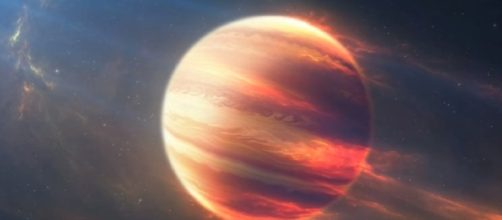On 5th June 2017, NASA discovered the hottest known planet in the Universe so far. Yes, you read that right! The surface temperature of KELT-9b is 4327-degrees Centigrade and it is hotter than 80 percent of the stars we know.
Comparison
So, exactly how hot is 4327-degree Centigrade?
Delhi, Kolkata, and Chennai (three metros whose residents often resort to memes on social media to complain about the daily weather) have average temperatures of 31, 32 and 33 degree Celsius respectively. KELT-9b is 135 times hotter! Even iron, the yardstick of endurance for our civilization gives way at 1538 degree Celsius!
That’s how crazy-hot KELT-9b is!
About the Planet
- KELT-9b orbits a star called KELT-9 and is situated about 620 light-years from Earth, in the constellation of Cygnus.
- The huge gas giant is so close to its host star that it takes just a day and a half to orbit.
- This exoplanet has a glowing, comet-style tail as it evaporates under the ultraviolet radiation from KELT-9, which is almost twice as hot as our Sun.
- KELT-9b is almost three times bigger than Jupiter.
- It is about 1200K cooler than the surface of the Sun.
- KELT-9b is locked to the star by enormous gravitational tidal forces.
- It is estimated that The Planet loses almost 10 million kilograms of mass per second
- The dayside of the planet is perpetually bombarded by stellar radiation and as a result, it is so hot that organic molecules cannot exist.
The discovery was described in a paper titled “A giant planet undergoing extreme Ultraviolet irradiation by it’s hot, massive star host” published by the esteemed Nature journal.
The planet and it’s host star were named after the survey that discovered it, the Kilodegree Extremely Little Telescope (KELT). It is classified as a planet by any of the typical definitions based on mass but it’s atmosphere, however, is most exotic, as it gets evaporated owing to the extreme heat. In fact, researchers are perplexed as to how the planet survives after suffering such insane heat.
The reason for this insane heat is the intimate proximity the gas giant has to its star, which is itself among some of the hottest stars we know, reaching temperatures of roughly 10,170 K. Astronomers believe that elements like gases and metals found on or around KELT-9b can only exist as atoms, not molecules.
Scientists usually focus on tracking exoplanets around smaller, dimmer stars like our Sun, because they are easier to spot and are most likely to house liveable planets outside our own corner of the galaxy. The discovery of hellish KELT-9b widens our arena of understanding of what could be out there.
Professor Scott Gaudi, of the Ohio State University, said, “The astronomical community is clearly focused on finding Earth-like planets around smaller, cooler stars like our Sun."
"It means that we can be perhaps even more audacious and imagine that we can have planets around even larger and brighter stars than we’ve ever hoped,” Alan Duffy, of Swinburne University told ScienceAlert.


